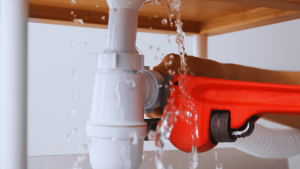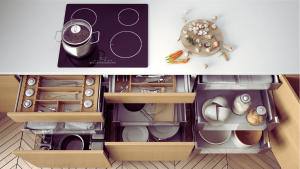Welcome to our comprehensive guide on how to clean your kitchen sink drain! A clogged sink drain can cause frustration and unpleasant odors in your kitchen. But fear not; we’re here to share our easy tips and tricks to help you keep your sink flowing smoothly, prevent clogs, and eliminate foul smells.
This section provides practical methods for cleaning your kitchen sink drain. Following these tips, you can remove debris and buildup, prevent clogs, and keep your sink clean and odor-free.
Key Takeaways:
- Regularly clean your kitchen sink drain to prevent clogs and unpleasant odors.
- Gather necessary supplies, such as baking soda and vinegar, a small brush or toothbrush, boiling water, and a plunger.
Gather Your Supplies
Before we begin cleaning your kitchen sink drain, having all the necessary supplies is essential. Here’s a list of what you will need:
| Supplies | Description |
|---|---|
| Baking soda | A versatile natural cleaner that can help dissolve stubborn clogs and remove odors from the drain. |
| Vinegar | A mildly acidic liquid that can help break down grease, grime, and mineral buildup in the pipes. |
| Small brush or toothbrush | Useful for scrubbing away residue and buildup around the drain opening. |
| Boiling water | A powerful flushing agent that can help dislodge any remaining clogs and dissolve any remaining debris. |
| Plunger | A valuable tool for dislodging stubborn clogs by using pressure to force them out. |
These supplies will make cleaning your kitchen sink drain more efficient and effective. With these tools, we can tackle even the toughest clogs and prevent them from reoccurring in the future.
Remove Debris and Buildup
Before diving into the actual cleaning process, removing any visible debris and buildup is essential. Don’t worry; it’s an easy step that can make a big difference.
If you have a sink stopper or strainer, start by removing it. Then, take a brush or toothbrush and scrub away any gunk or residue accumulated around the drain opening. This will ensure that your cleaning efforts are more effective, allowing the cleaning solution to reach deeper into the pipes.
Remember not to push any debris further down the drain. Instead, try to remove it altogether. If you’re dealing with stubborn buildup, a small tool like a toothpick or tweezers can help dislodge it.
Tip: For future prevention, try to scrape off any large food scraps into the trash before washing dishes and using a sink strainer to catch any small bits that may escape.
Use Baking Soda and Vinegar
If you’re looking for a natural and effective way to clean your kitchen sink drain, look no further than baking soda and vinegar. These two household staples work together to dissolve buildup and unclog your drain.
To unclog your drain, pour approximately half a cup of baking soda into it. Follow with half a cup of vinegar. The mixture will begin to fizz and break down any buildup in the pipes. Let it sit for a few minutes before flushing the drain with boiling water.
Repeat the process or move on to another method if the clog persists.
Plunge Away the Clogs
If the method of using baking soda and vinegar does not work, completely clear the clog, don’t worry. We’ve got another trick up our sleeves – the plunger! Ensure you’ve covered the overflow opening with a wet cloth to create a seal. Then, plunge the drain vigorously several times. This action creates pressure that can dislodge even stubborn clogs.
If the water starts to drain slowly but doesn’t clear completely, keep plunging. Sometimes the clog might move further down the pipe, making removing it harder. However, persistence pays off, so keep at it! If the clog still refuses to budge, seeking professional help is best.
Hot Water Flush
Regularly flushing your kitchen sink drain with hot water can help prevent clogs and keep it clean. Once a week, boil a water kettle and carefully pour it down the drain. The hot water will help dissolve any grease or soap residue clinging to the pipes, keeping your drain flowing smoothly.
DIY Drain Snake
If you’re dealing with a stubborn clog that won’t budge, don’t panic. You can create your DIY drain snake with just a wire hanger. Straighten out the hanger and bend one end into a small hook shape. Insert the hooked end into the drain and gently wiggle it around to loosen the clog. Be careful not to apply too much force, or you may damage the pipes. Pull out any debris that comes up with the wire.
Remember to proceed cautiously when attempting to clear a clog with a DIY method. Call in professional kitchen sink drain cleaning services if unsure.
Avoiding Clogs in the Future
Prevention is vital for keeping your kitchen sink drain clean and clog-free.
- It is recommended to avoid pouring grease. oil, or coffee grounds down the drain. they can solidify and cause blockages.
- Consider using a sink strainer to collect any leftover food particles. empty it regularly.
- Avoid putting fibrous foods like celery or potato peels down the drain, as they can tangle and create clogs.
Following these simple tips can avoid future problems with your kitchen sink drain. It’s important to remember that putting in even a small amount of effort can help you avoid potential problems. major plumbing headaches down the line.
Call in the Professionals
Despite our best efforts, sometimes DIY methods just don’t cut it. Persistent clogs or foul odors may require the expertise and specialized tools of professional kitchen sink drain cleaning services. These professionals have the knowledge and experience to tackle even the toughest drain problems.
If you’re experiencing ongoing issues despite your best efforts, feel free to reach out to a professional service. Identifying the root cause of the problem is something that they can assist with. provide a long-term solution. By investing in professional cleaning, you can save yourself from future headaches and potentially costly repairs.
Conclusion
Keeping your kitchen sink drain clean and clog-free may seem daunting, but with a little effort and the right tools, it can be a breeze. Following the tips and tricks we’ve provided can prevent future clogs and odors and keep your sink flowing smoothly.
Remember to gather your supplies ahead of time, remove debris and buildup regularly, and use natural cleaners like baking soda and vinegar. If all else fails, you can create your own DIY drain snake or seek help from professional kitchen sink drain cleaning services.
Maintaining prevention is crucial in ensuring a healthy state. clean and healthy kitchen sink To prevent clogging, it’s best to refrain from dumping grease, oil, or coffee grounds into the drain. and use a strainer to catch food scraps. One way to prevent clogs in the drain is by regularly flushing it with hot water.
By utilizing these simple tips and techniques, You will be able to reach the outcome you want. effortlessly. avoid major plumbing headaches down the line and keep your kitchen sink drain working efficiently. Happy cleaning!
FAQ
Q: How do I clean my kitchen sink drain?
A: These tips and tricks make cleaning your kitchen sink drain easy. Start by gathering your supplies, such as baking soda, vinegar, a brush, boiling water, and a plunger. Then, remove any debris and buildup around the drain opening. You can create a mixture by combining baking soda and vinegar to achieve a desired result. unclog and deodorize the drain. If needed, use a plunger to dislodge stubborn clogs. To keep your drain clean, make sure to flush it with hot water frequently. It is recommended to avoid pouring grease or oil. food scraps down the drain. If all else fails, consult professional kitchen sink drain cleaning services.
Q: What supplies do I need to clean my kitchen sink drain?
A: To clean your kitchen sink drain, gather baking soda, vinegar, a brush or toothbrush, boiling water, and a plunger. These supplies will help you effectively remove clogs and keep your drain flowing smoothly.
Q: How do I remove debris and buildup from my kitchen sink drain?
A: Start by removing the sink stopper or filter, if applicable. Then, use a brush or toothbrush to remove any visible debris and buildup around the drain opening. This will ensure that your cleaning efforts are more effective.
Q: How do I use baking soda and vinegar to clean my kitchen sink drain?
A: To unclog a drain, Add half a cup of baking soda to the mixture. add half a cup of vinegar. Allow the solution to sit for a while. the mixture fizz and work its magic for a few minutes. Next, pour boiling water down the drain to clear any blockages. loosened debris. This natural method is effective in unclogging and deodorizing your kitchen sink drain.
Q: What should I do if the baking soda and vinegar method doesn’t work?
A: If the baking soda and vinegar method doesn’t fully clear the clog, use a plunger. Cover the overflow opening (if present) with a wet cloth to create a seal. Vigorously plunge the drain several times to create pressure to dislodge stubborn clogs. Repeat as needed until the drain is clear.
Q: How often should I flush my kitchen sink drain with hot water?
A: It is recommended to flush your kitchen sink drain with hot water once a week. To clear the drain, boil some water in a kettle and pour it down slowly and carefully. hot water will help dissolve grease or soap residue, preventing clogs and cleaning your drain.
Q: How can I create a DIY drain snake?
A: To create a DIY drain snake, To create a small hook, take a wire hanger and straighten it out. Then, bend one end of the wire into the desired shape. shape. Insert the hooked end into the drain and gently wiggle it around to loosen the clog. Pull out any debris that comes up with the wire. Exercise caution to avoid damaging the pipes.
Q: How can I prevent clogs in my kitchen sink drain?
A: To prevent clogs in your kitchen sink drain, avoid pouring grease, oil, or coffee grounds down the drain. To prevent food scraps from going down the drain, it is advisable to use a sink strainer. empty it regularly. Also, avoid putting fibrous foods like celery or potato peels down the drain, as they can tangle and create clogs.
Q: When should I call professional kitchen sink drain cleaning services?
A: If DIY methods aren’t providing the desired results and you’re still experiencing persistent clogs or foul odors, it’s time to seek help from professional kitchen sink drain cleaning services. They have the tools and expertise to tackle the most challenging drain problems.

It’s me, Amber Hayden, the heart and soul behind SagarmathaOnlineMedia.com. From a young age, I’ve been head over heels for everything home-related, from interior decor to gardening. I’m the type who can’t resist a well-crafted piece of furniture, and I firmly believe that a home isn’t complete without a pet or two. But it’s not just about creating pretty spaces for me. I’m all about making homes that tell a story reflecting the people living there. SagarmathaOnlineMedia.com is my way of sharing this passion with you. Whether you’re looking for tips to jazz up your living room, advice on pet care, or ideas to make your garden bloom, I’m here to help. So, let’s embark on this journey together and make your house a home!



